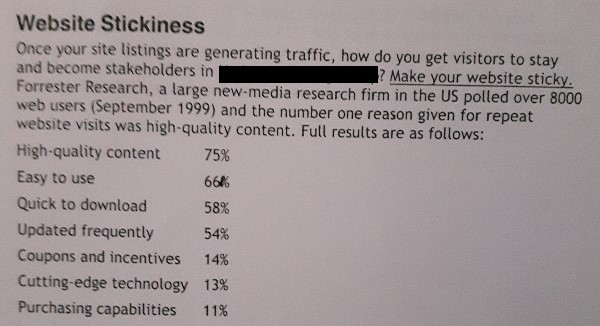Website Findability Fundamentals Haven’t Changed
I was doing my annual office declutter and found a consulting deliverable I created in February 2000 – almost 18 years ago! It’s entitled “Increasing Website Findability”. After a quick skim I discovered that I still give a lot of the same counsel today. Hunh?
Think about how much the web has changed since 2000. Smartphones and mobile design, video and photos, social media, self publishing and open-source CMS, AR and VR, and the internet of things, are all new. When you realize that these are different containers and formats for content, and people are still just looking for answers, I guess I shouldn’t be surprised. The fundamentals of findability still hold true.
Here is a snippet from the Purpose. There are a few things showing its age:

- Search engines is plural. Google was still a baby at the time and they were one of at least a dozen search engines fighting for market share: Lycos, Excite, Dogpile…
- Search directories – Yes, there was a distinction. Getting properly categorized in Yahoo – by a human – was essential.
- “Link popularity” and “website stickiness” were the buzzwords du jour. They are no less relevant today in creating a great user experience, just not as groovy.
Side note…the term “user experience” doesn’t appear anywhere in the 13 pages, but that’s exactly what these recos are all about.)
Top 4 website stickiness factors
 The section on website stickiness has some interesting numbers. If I didn’t tell you these stats were from 1999, you’d probably think they were more recent. The top 4 reasons given for repeat website visits are: high quality content, easy to use, quick to download, and updated frequently. These are still table stakes. The one that might give it away is “Purchasing capabilities” at 11%. This is undoubtedly much higher today.
The section on website stickiness has some interesting numbers. If I didn’t tell you these stats were from 1999, you’d probably think they were more recent. The top 4 reasons given for repeat website visits are: high quality content, easy to use, quick to download, and updated frequently. These are still table stakes. The one that might give it away is “Purchasing capabilities” at 11%. This is undoubtedly much higher today.
As the report concludes, there is one factor missing that I wouldn’t ignore today: conversion. While it speaks to quality traffic as a goal, there is no mention of what qualified people should or will do, or how we’ll know if it was successful.

The more things change, the more they stay the same
Digital containers and formats will continue to evolve. Human nature likes a much slower pace. There will never be a time when poor, difficult, slow and stale content is in demand. And yet we invest in the latest containers and formats, often at the expense of our content, to keep it looking shiny even if it isn’t. I guess that’s human nature too.
